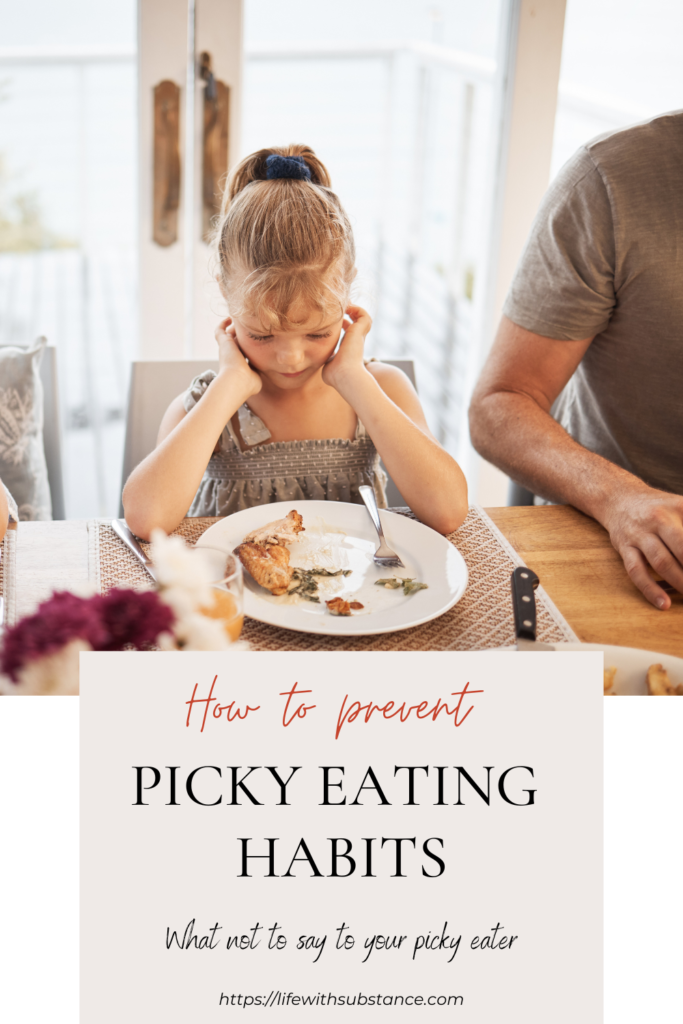This post may contain affiliate links. If you shop from one of our links, we may earn a commission.
Feeding a picky eater at home can feel stressful enough. Now add in trying to feed your picky eater at a potluck or friend’s house and you may want to pull your hair out. The hard part about eating somewhere else is that you never quite know how the food is prepared. A fan-favorite box of Kraft mac and cheese is totally different than a simple recipe of homemade mac and cheese in the eyes of a picky eater. Or maybe your kid loves your pasta salad made with rotini noodles, but the host made theirs with penne noodles. These minor changes could cause your child to spiral into an embarrassing tantrum because they “don’t like anything” which can make for an unpleasant dining experience with extended family and friends.
As a dietitian, I really thought that because I had all the “tools” to promote an adventurous eater that certainly my kids would be the one at the potluck trying all the new foods. I was brought back to reality pretty quickly. One thing I have learned as a mom to 3 little ones is to give yourself plenty of grace.
We can do all the feeding tricks by the book and still end up with a fussy eater. The reality is that there is so much that goes into feeding young kids. Each child is unique in their eating style and preferences. Issues such as sensory sensitivities. medical complications, peer influence, development, and environment can make a huge impact on how adventurous of an eater your child becomes.
But there are some things in our control that we can do to help the dining experience to be an enjoyable one for everyone involved.
5 Tips for Surviving the Potluck with a Picky Eater
Let’s break this down into 5 tips to help your picky eater (and yourself) enjoy potluck dinners without the meal time battles.

1. Practice the Division of Responsibility
Wouldn’t it be wonderful to take your kid to a potluck and they love almost every food there? And any new foods they would gladly put on their plate to try without a fuss? Alright, back to reality. While there are some unicorn kids out there, I realize that isn’t the norm. And that’s where the Division of Responsibility comes into play.
The Division of Responsibility is a highly researched and effective feeding system that establishes boundaries for both you and your child. It helps kids to develop trust around food and learn to recognize their own hunger and fullness cues.
With this method, you as the parent are in charge of what your kid is going to eat, when they will eat, and where. Your child’s role is to decide how much they want to eat and whether they want to eat the food offered. Setting boundaries around your roles in feeding can significantly reduce stress at family meals and decrease picky eating.
Frustrations and meltdowns can be spared by arriving at the potluck with expectations of feeding already established.

2. Bring a safe food
Every family has their own way of making familiar foods. Your kid may love your potato salad, but it could be entirely different than the one your friend made. Because we all know there are dozens of potato salad recipes out there. A little thing like your friend’s crowd pleaser side dish that is different than their familiar favorite can lead to major meltdowns. By bringing a preferred or safe food to the cookout, your child can rest assured that they have something they can fill up on.
Opting to bring a dish that your child loves and feels comfortable with, be it their favorite potato salad, fruit platter, or even a batch of homemade cookies, can significantly reduce mealtime stress. It serves not only as a guaranteed option for them to eat but also as a subtle encouragement to try different foods. With their trusted dish by their side, they might just feel bold enough to try a small spoonful of something new, knowing they have their preferred food to return to. Going back to the division or responsibility, remember, it’s okay if they choose to only eat hot dogs. You’re still providing opportunities for exposure to new foods.
Is this catering to fussy eating? Only offering preferred foods at home can definitely encourage picky eating. However, going to someone’s house with a variety of new or learning-to-like foods can be very overwhelming for picky eaters. Add in all the extra stimulation and people for increased anxiety for little ones. Reassuring them that there is something they can enjoy makes a huge difference. Don’t we even feel that way as adults?
3. Don’t let your picky eater show up hungry
Navigating the bustling atmosphere and distractions of other kids at a potluck dinner with a picky eater in tow requires a bit of pre-event strategizing, particularly when it comes to hunger management. Eating with others also means your child doesn’t eat on their usual schedule. For some little ones, it doesn’t take much time difference to go from happy to hangry.
One key tactic is ensuring your child doesn’t arrive on an empty stomach, which might seem counterintuitive at first. After all, isn’t the point of going to a potluck to feast on the smorgasbord of options? However, bringing a picky eater who is ravenous to such an event can amplify any food-related anxieties they might have, making them even less inclined to try new foods.
To sidestep this potential pitfall, consider offering your child a light snack before you leave home. This isn’t about spoiling their appetite but rather about preventing them from hangry meltdowns.

4. Explain the expectations
I always find my kids handle scenarios way better when they know what to expect and what is expected of them in advance. Preparing your picky eater for the exciting variety of a potluck begins long before you step through the host’s doorway.
A thoughtful, pre-potluck discussion can set the stage for a positive and exploratory mealtime experience. Engage your child in a gentle conversation about the array of dishes they might encounter, highlighting the adventure of trying something new alongside the comfort of familiar foods. Emphasize the joy of friend and family gatherings and the shared experience of mealtime, where everyone contributes something unique to the table.
This isn’t about setting ultimatums or pressuring them to eat everything in sight. Instead, it’s about promoting curiosity, respect for different foods, and an understanding that it’s perfectly okay to have preferences. Let them know it’s fine to find some dishes more appealing than others and that you’re there to support their food exploration journey every step of the way.
This preparatory talk is also an ideal time to introduce the idea of a “no thank you” portion—a small, manageable taste of a new dish they’re unsure about. It’s a great way to assure them that it’s an option to try new meals without the commitment of a full serving, reinforcing the message that their comfort and preferences are always valued.
Talk to your child about there being a variety of food options there that can be fun to try, and reassure them you brought something they enjoy. However, if your child does not feel comfortable trying a new food at this time, don’t pressure them to eat it. This only amplifies their anxiety and unwillingness to try it.
By setting clear ground rules and positive expectations before arriving at the potluck, you’re not just preparing your child for a single meal but are also instilling valuable lessons in food exploration and open-mindedness that will serve them well beyond the family dinner table. This proactive approach paves the way for a more relaxed, enjoyable potluck experience for both of you.
5. Avoid picky eater comments
Want to know one of the best ways to keep your kid a picky eater? Tell them and others that they are a picky eater. It won’t take long for them to embrace the title and choose to be finicky about their food choices.
One comment I truly don’t like is, “You won’t like this.” If you want your child to become an adventurous eater, help them be excited about trying new foods and using their 5 senses. Instead of focusing on what they’re not eating, celebrate their successes, no matter how small. If they so much as sniff a new dish or poke at it with a fork, that’s progress. Positive reinforcement can significantly help their confidence and might even encourage them to take a small taste next time.
Remember, the dinner table isn’t the place for discussions about picky eating habits. Comments that highlight their reluctance to try new foods can inadvertently create feelings of shame or anxiety around eating. Such emotions can reinforce picky eating behaviors rather than help overcome them. Instead, focus on making mealtime a positive and stress-free experience for your child. Offer gentle encouragement and let them know how proud you are when they show curiosity about a new food.
It’s also helpful to lead by example. Show enthusiasm for the dishes available, try new items yourself, and express your enjoyment. This can pique your child’s interest and demonstrate that trying new foods is both fun and rewarding.
By steering clear of negative commentary and instead fostering an environment of encouragement and curiosity, you’re not only making the potluck more enjoyable for your picky eater but also laying the groundwork for a healthier relationship with food in the long run.

In Summary
Navigating a potluck with a picky eater can be a challenging task. But, with careful planning and open communication with your child, it can become an enjoyable experience.
Preparing a dish that your child enjoys is one helpful strategy, as this ensures they will have something to eat. Using the division of responsibility, encourage your child to try new foods but respect their choices if they decline. The goal is to help them gradually broaden their palate without causing unnecessary stress or pressure. Remember, a dinner party is not the time to make your child try new recipes if they do not feel comfortable. There will be plenty of opportunities for that at home.
The good news is that while there are certainly some things out of your control, there are many things you can do to help your child expand their diet. Check out my free picky eating guide for more tips!

